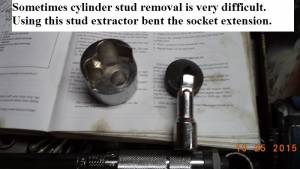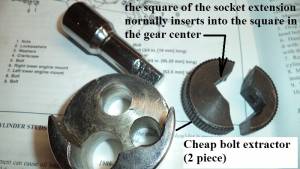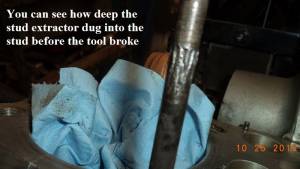Table of Contents
This is an old revision of the document!
EVO: Engine Mechanicals - Sub-03A
Cylinder / Head Bolt Issues and Repair
Sub Documents
See also Time-Sert repair on engine case using drill press in the Sportsterpedia for cylinder / head stud repair.
Loose Head Bolt Studs
A big concern about the studs becoming loose is the threads being stripped in the case.
The two side by side bolt holes on the right side in the pic below are each drilled into the opposing holes and tapped.
So each hole is depending, in part, of the strength of the other.
With the bolts loosening, it is at least suspect that the threads or the hole strength is compromised. 1)
| Weakest head stud holes in the case. 2) |
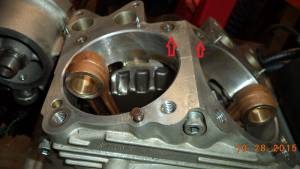 |
There is a procedure in the manual for tightening the studs before installing the cylinders and heads.
Basically you put a steel ball on top of the stud, then a head bolt cap on top of that.
The ball allows you to achieve spec'd torque and still remove the nut without unscrewing the stud from the case.
This 'sets' the studs into the case in addition to the torque applied to the head bolts.
Without the initial torque on the studs, they are totally dependent on the torque of the head bolts.
But they shouldn't back out unless either they weren't installed right to begin with or the hole has been stripped / compromised.
If a stud is backing out, it could have simply be from it being installed improperly to begin with.
It is possible that the stud turned when the head cap nuts were removed.
Heat plays a role in what happens to the studs / nuts also and can lock the cap screw tighter than the stud is to the case.
So it is possible that the top nut was just tight to the stud before breaking loose.
First try and remove any studs that back out and check the threads in the case as well as the stud.
It is also possible to burr the stud threads by dropping them on installation and subsequently ruin the case threads when turning the stud in.
Sometimes the studs will stretch upon torque (especially too much torque).
If this happens, the wrench will say you hit torque, but when you release pressure, the stud spins with you back to it's relaxed state.
In that case, you did not get to final torque. Just something to think about when torque'ing the heads.
Be aware that the stud itself could stretch (or twist in the middle).
You can feel when this happens. It takes longer to get to torque due to the stud turning with you in the middle.
Always follow the torque sequence in the FSM and or your engine builder /supplier when installing the head bolts.
This will also cause a leak if not done properly.
Stud Removal
The idea below to soak the threads in oil was in response to the broken tool(s) above.
Due to the angle of the block, it's not possible to actually leave anything next to the threads since it will simply slide down the block.
So a 'holding chamber' was made to let the oil sit and penetrate the threads.
The block was cleaned of oil and wiped down with acetone on a rag.
The a small piece PVC pipe was silicone to the block and let cure.
Lube oil (in this case cutting oil) was poured into the PVC to soak the stud threads overnight.
This made removing the stud with an 18“ pipe wrench easier the next day.
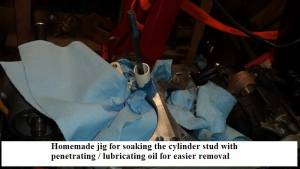 3)
3)
Stripped Case Threads
These could be repaired with Heli-coils.
But the repair must be straight with no wobble when drilling.
So it's best to split the cases and take them to a reputable machine shop to have that done.
In the pic below, notice the small clearance between the studs and the holes they run in.
The case threads have to be in perfect alignment to the stud holes in the cylinder.
If not, the cap nuts will not fit on the studs to install them.
The stud would have to be wedged to get the nuts on.
This puts the nuts in a bind when using torque.
It will effectually hit torque on the wrench way before the nut is actually that tight.
It can also warp the studs.
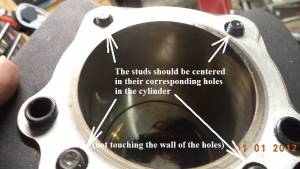 4)
4)

